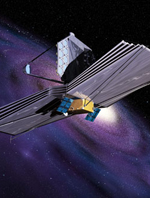
Image credit: ESA
An agreement between ESA and seven Member States to jointly build a major part of the MIRI instrument, which will considerably extend the capability of the James Webb Space Telescope (JWST), was signed, 8 June 2004.
This agreement also marks a new kind of partnership between ESA and its Member States for the funding and implementation of payload for scientific space missions.
MIRI, the Mid-Infrared Instrument, is one of the four instruments on board the JWST, the mission scheduled to follow on the heritage of Hubble in 2011. MIRI will be built in cooperation between Europe and the United States (NASA), both equally contributing to its funding. MIRI?s optics, core of the instrument, will be provided by a consortium of European institutes. According to this formal agreement, ESA will manage and co-ordinate the whole development of the European part of MIRI and act as the sole interface with NASA, which is leading the JWST project.
This marks a difference with respect to the previous ESA scientific missions. In the past the funding and the development of the scientific instruments was agreed by the participating ESA Member States on the basis of purely informal arrangements with ESA. In this case, the Member States involved in MIRI have agreed on formally guaranteeing the required level of funding on the basis of a multi-lateral international agreement, which still keeps scientists in key roles.
Over the past years, missions have become more complex and demanding, and more costly within an ever tighter budget. They also require a more and more specific expertise which is spread throughout the vast European scientific community. As a result, a new management procedure for co-ordination of payload development has become a necessity to secure the successful and timely completion of scientific space projects. ESA?s co-ordination of the MIRI European consortium represents the first time such an approach has been used, which will be applied to the future missions of the ESA long-term Science Programme ? the ?Cosmic Vision?. The technology package for LISA (LTP), an ESA/NASA mission to detect gravitational waves, is already being prepared under the same scheme.
Sergio Volonte, ESA Co-ordinator for Astrophysics and Fundamental Physics Missions, comments: ?I?m delighted for such an achievement between ESA and its Member States. With MIRI we will start an even more effective co-ordination on developing our scientific instruments, setting a new framework to further enhance their excellence.?
The James Webb Space Telescope (JWST), is a partnership between ESA, NASA and the Canadian Space Agency. Formerly known as the Next Generation Space Telescope (NGST), it is due to be launched in August 2011, and it is considered the successor of the NASA/ESA Hubble Space Telescope. It is three times larger and more powerful than its predecessor and it is expected to shed light on the ‘Dark Ages of the Universe’ by studying the very distant Universe, observing infrared light from the first stars and galaxies that ever emerged.
MIRI (Mid-Infrared Camera-Spectrograph) is essential for the study of the old and distant stellar population; regions of obscured star formation; hydrogen emission from previously unthinkable distances; the physics of protostars; and the sizes of ?Kuiper belt? objects and faint comets.
Further to the contribution to MIRI, Europe through ESA is contributing to JWST with the NIRSPEC (Near-Infrared multi-object Spectrograph) instrument (fully funded and managed by ESA) and, as agreed in principle with NASA, with the Ariane 5 launcher. The ESA financial contribution to JWST will be about 300 million Euros, including the launcher. The European institutions involved in MIRI will contribute about 70 million Euros overall.
The European institutions who signed the MIRI agreement with ESA are: the Centre Nationale des Etudes Spatiales (CNES), the Danish Space Research Institute (DSRI), the German Aerospace Centre (DLR), the Spanish Ministerio de Educaci?n y Ciencia (MEC), the Nederlandse Onderzoekschool voor Astronomie (NOVA), the UK Particle Physics and Astronomy Research Council (PPARC) and the Swedish National Space Board (SNSB).
Four European countries, Belgium, Denmark, Ireland and Switzerland contribute to MIRI through their participation into ESA?s Scientific Experiment Development programme (PRODEX). This is an optional programme, mainly used by smaller countries, by which they delegate to ESA the management of funding to develop scientific instruments.
The delivery to NASA of the MIRI instrument is due for March 2009.
Original Source: ESA News Release
